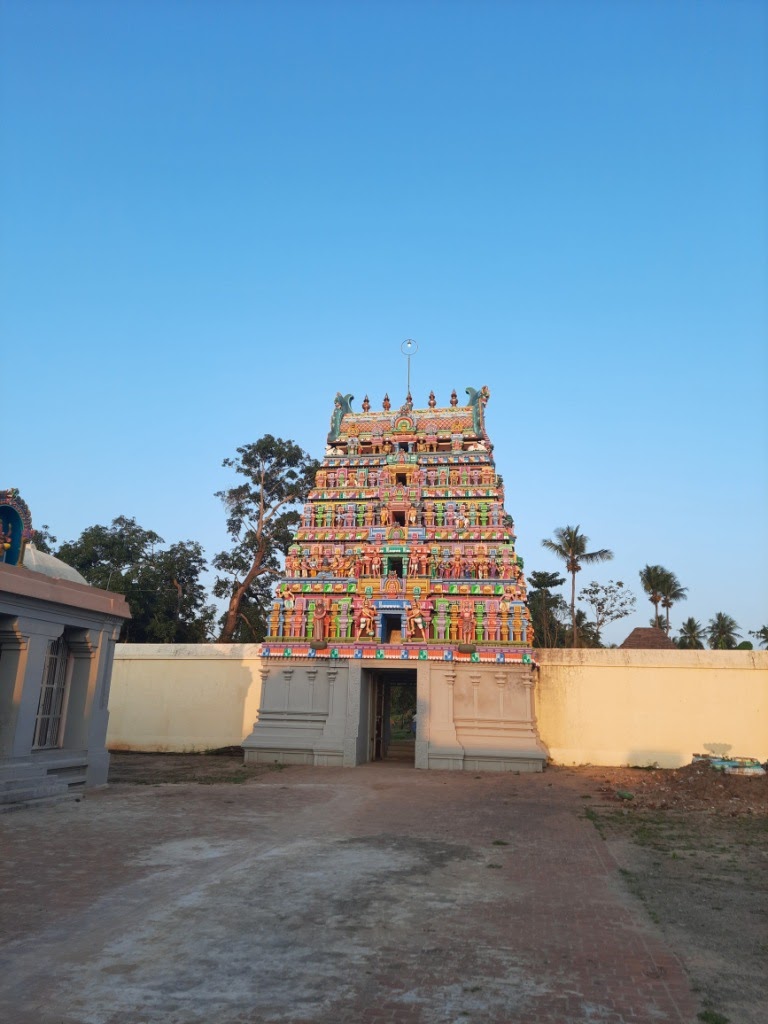Tiruvilanagar Sri Uchiravaneswarar Temple, Nagapattinam

Address
Tiruvilanagar Sri Uchira Vaneswarar (Thurai Kattum Vallalar) Temple, Thiruvila Nagar, Arupathy Post, Mayiladuthurai Taluk, Nagapattinam District, Tamil Nadu – 609 309. Tele: +91 4364 282 129.
Diety
Uchiravaneswarar, Thuraikattum Vallalar Amman: Veyurutholi
Introduction
Uchiravaneswarar Temple is a Hindu Temple dedicated to Lord Shiva located in Thiruvilanagar village near Mayiladuthurai Town in Tharangampadi Taluk in Nagapattinam District of Tamil Nadu. The Temple is also called as Thurai Kaattum Vallalar Temple. Presiding Deity is called as Uchiravaneswarar / Thurai Kaattum Vallalar and Mother is called as Veyuru Tholi Ammai / Thurai Kaattum Valli. It is one of the shrines of the 276 Paadal Petra Sthalams – Shiva Sthalams glorified in the early medieval Tevaram poems by Tamil Saivite Nayanar Tirugnanasambandar.This Temple is considered as one of the shrines of the 276 Paadal Petra Sthalams glorified in the early medieval Thevaram hymns. This Temple is the 157th Devara Paadal Petra Shiva Sthalam and 40th sthalam on the south side of river Cauvery in Chozha Nadu. This temple is considered as one of the Pancha Dakshinamoorthy Sthalams around Mayiladuthurai. This temple is considered as one of the Vallal Temples of Mayiladuthurai. Theertham (Holy water): Cauveri river, Meygnana Theertham Sthala Vriksham (Sacred Tree): Vizhal plants
Puranic Significance
The Temple might have been built in 6 th century CE. The Temple was completely reconstructed in granite during the Chola period. Later, the temple was extensively renovated by Pandyas and Thanjavur Nayaks. There are about three inscriptions recorded from this temple. There is an inscription dated to the 5 th regnal year of Uthama Chola. This inscription records the donation of a land by the queen ofUthama Chola for conducting the ardha jama pooja. According to legend, there was a brahmin boy called Arulvithan who used to worship the lord here. He would bring offerings of flowers every day without fail. He had to cross the river Kaveri in order to reach the temple. One day, the river got flooded making it very dangerous to cross. Even then he decided to cross the river but got caught in the flood. Instead of trying to save his life he tried saving the flowers he had brought for the lord’s pooja. Pleased with his determination and devotion, Lord Shiva rescued him. Hence the lord here is praised as “Thurai Kaattum Vallal”. (“Thurai” means river bank, “Kaattum” means to show and “Vallal” means philanthropist in Tamil). Another similar legend associated with this temple is that of Saint Thirugnanasambanthar. When he was on a pilgrimage to Kadaimudi and Mayiladuthurai, he could not proceed further due to heavy floods in the river Kaveri. The saint prayed to Lord Shiva seeking his help in crossing the river. It is believed that Lord Shiva came in the guise of a hunter and helped him reach the temple. As per the Sthala Purana, a demon called Kapithan worshiped the lord of this temple and got relieved from the “Brahmahathi Dosham”.
Beliefs
Devotees believe that worshiping the lord here would help in obtaining quick resolutions of their problems. It is also believed that worshiping the lord here would help devotees break away from the repetitive cycle of birth and re-birth. The Sthala Viruksham of this temple is the Vizhal plant. Devotees tie its leaves in a knot in the hope that their prayers would be heard.
Special Features
Goddess Veyuru Tholi Amman is holding a discus in one hand and a conch in the other. In his hymn, Saint Thirugnanasambanthar mentioned about the incident of crossing the river and praised the lord as “Cauvery Thurai Kattinar” (the lord who showed the way to reach the river bank). The temple is facing towards east with five tiered rajagopuram. There is another entrance arch on the southern side. This entrance arch has stucco images of Goddess Parvathy flanked by Goddesses Saraswathi and Maha Lakshmi. The Temple covers an area of about 2.5 acres and has two prakarams. Balipeedam and Nandi can be found immediately after the rajagopuram facing towards the sanctum. Asthana Mandapa can be seen on the left side immediately after the rajagopuram. There is an entrance arch at the entrance of the inner prakaram. Idols of Vinayaga can be seen on both the sides of the entrance. The sanctum sanctorum consists of sanctum, antrala and maha mandapam. Nandi and Balipeedam can be seen in front of the sanctum. Presiding Deity is called as Uchiravaneswarar / Thurai Kaattum Vallalar and is facing east. He is housed in the sanctum in the form of Lingam. Lord is a Swayambhu Moorthy (self-manifested). The vimana over the sanctum is of two tiers. Dakshinamoorthy, Vishnu, Brahma and Durga are the koshta idols located around the sanctum walls. Mother is called as Veyuru Tholi Ammai / Thurai Kaattum Valli. She is housed in a separate south facing shrine. Her shrine is situated in maha mandapam to the left side of the sanctum. She is in standing posture holding a discus in one hand and a conch in the other. Shrines of Nataraja and Navagrahas can be seen on the left side immediately after the second level entrance. Shrines of Vinayaga, Somaskanda, Murugan with his consorts Valli & Devasena, Naalvar, Arunachaleswarar, Gaja Lakshmi, Surya, Chandran, Saneeswarar and Bhairavar can be seen in the inner prakaram. Theertham associated with this temple are Meignana Theertham and Cauvery river. Sthala Vriksham is Vizhal plant.
Festivals
Vinayakar Chaturthi in the Tamil month of Aavani (Aug-Sept), Navarathri in the Tamil month of Purattasi (Sept-Oct), Annabishekam in the Tamil month of Aippasi (Oct–Nov), Makara Sankranthi in the Tamil month of Thai (Jan-Feb), and Maha Shivrathri in the Tamil month of Maasi (Feb-Mar). Pradosham is also observed regularly.
Century/Period/Age
1000-2000 years
Managed By
HRCE
Nearest Bus Station
Tiruvilanagar
Nearest Railway Station
Mayiladuthurai
Nearest Airport
Trichy





